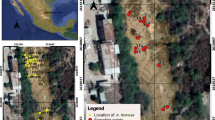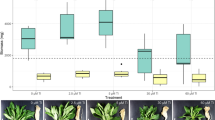Abstract
Environmental scanning electron microscope (ESEM) fitted with an energy dispersive X-ray microanalyzer (EDX) was used to investigate the surface micromorphology and arsenic (As) micro-distribution in Chinese brake (Pteris vittata L.). It was found that amounts of trichome, which possessed multicellular structure with the average length of 160 μm and with an average diameter of 28 μm, existed in the frond ofP. vittata, and the density of trichome on the pinnate axial surface was higher than that on the petiole. Visible X-ray peak of As was recorded in the epidermal cell and trichome. The relative weight of As in the pinnate trichome, which contained the highest concentration of As among all tissues of the plant, was 2.4 and 3.9 times as much as that in the epidermal and mesophyllous cells, respectively. The As concentrations in the basal and stalk cells of the same trichome were higher than that in its cap cell. This is the first time to report that the trichome ofP. vittata plays an important role in arsenic hyperaccumulation. The finding from the present study implies that much attention should be paid to the role of the trichome in understanding the hyperaccumulation and detoxicity of As in the hyperaccumulator and improving the ability of As accumulation.
Similar content being viewed by others
References
Chen, T. B., Wei, C. Y., Huang, Z. C. et al., Arsenic hyperaccumulatorPteris vittata L. and its arsenic accumulation, Chinese Science Bulletin, 2002, 47(11): 902–905.
Chen, T. B., Wei, C. Y., A method to remediate arsenic contaminated soils, 2001, China Patent No. CN01120519.9.
Liao, X. Y., Chen, T. B., Xie, H. et al., Effect of application of P fertilizer on efficiency of As removal from As-contaminated soil using phytoremediation: Field study, Acta Scientiae Circumstantiae (in Chinese), 2004, 24(3): 455–462.
Webb, S. M., Gaillard, J. F., Ma, L. Q. et al., XAS speciation of arsenic in a hyperaccumulating fern, Environmental Science & Technology, 2003, 37: 754–760.
Zhao, F. J., Dunham, S. J., McGrath, S. P., Arsenic hyperaccumulation by different fern species, New Phytologist, 2002, 156: 27–31.
Wang, J. R., Zhao, F. J., Meharg, A. A. et al., Mechanisms of arsenic hyperaccumulation inPteris vittata. uptake kinetics, interactions with phosphate, and arsenic speciation, Plant Physiology, 2002, 130: 1552–1561.
Zhang, W., Cai, Y., Tu, C. et al., Arsenic speciation and distribution in an arsenic hyperaccumulating plant, The Science of the Total Environment, 2002, 300: 167–177.
Chen, T. B., Huang, Z. C., Huang, Y. Y. et al., Cellular distribution of arsenic and other elements in hyperaccumulatorPteris nervosa and their relations to arsenic accumulation, Chinese Science Bulletin, 2003, 48(11): 1163–1168.
Lombi, E., Zhao, F. J., Fuhrmann, M. et al., Arsenic distribution and speciation in the fronds of the hyperaccumulatorPteris vittata, New Phytologist, 2002, 156: 195–203.
Liang, Y. C., Ding, R. X., Influence of silicon on micro-distribution of mineral ions in roots of salt-stressed barley as associated with salt tolerance in plants, Science in China, Ser. C, 2002, 45(3): 298–308.
Ranger, C. M., Hower, A. A., Glandular morphology from a perennial alfalfa clone resistant to the potato leafhopper, Crop Science, 2001, 41: 1427–1435.
Liao, X. Y., Chen, T. B., Lei, M. et al., Root distributions and elemental accumulations of Chinese brake (Pteris vittata L.) from As-contaminated soils, Plant and Soil, 2004, 261: 109–116
Wagner, G. J., Wang, E., Shepherd, R. W. et al., New approaches for studying and exploiting an old protuberance, the plant trichome, Annals of Botany, 2004, 93: 3–11.
Wagner, G. J., Secreting glandular trichomes: More than just hairs, Plant Physiology, 1991, 96: 675–679
Bao, W. M., Wang, Q. X., Ao, Z. W., Studies on the development of gametophytes of ferns from north-eastern China: VIII aspleniaceae, Bulletin of Botanical Research (in Chinese), 1995, 15(1): 61–64.
Zeng, H. Y., Ding, B. Y., Studies on the gametophytes development in ferns, Bulletin of Botanical Research (in Chinese), 2003, 23(2): 154–158.
Nishida, R., Kawai, K., Amano, T. et al., Pharmacophagous feeding stimulant activity of neo-clerodane diterpenoids for the turnip sawfly,Athalia rosae ruficornis, Biochemical Systematics and Ecology, 2004, 32(1): 15–25.
Urzúa, A., Contreras, R., Jara, P. et al., Comparative chemical composition of the trichome secreted exudates and of the waxy coating fromHaplopappus velutinus, H. illiniyus, H. schumanni andH. uncinatus, Biochemical Systematics and Ecology, 2004, 32(2): 215–218.
Huang, Z. C., Chen, T. B., Lei, M. et al., EXAFS study on arsenic species and transformation in arsenic hyperaccumulator, Science in China, Ser. C, 2004, 47 (2): 124–129.
Psaras, G. K., Constantinidis, T. H., Cotsopoulos, B. Y., Relative abundance of nickel in the leaf epidermis of eight hyperaccumulators: Evidence that the metal is excluded from both guard cells and trichomes, Annals of Botany, 2000, 86(1): 73–78.
Cha, Y. E., Harada, E., Wada, M. et al., Detoxification of cadmium in tobacco plants: formation and active excretion of crystal containing cadmium and calcium through trichome, Planta, 2001, 213: 45–50.
Ager, F. J., Ynsa, M. D., Domínguez, J. R. et al., Nuclear micro-probe analysis ofArabidopsis thaliana leaves, Nuclear Instruments and Methods in Physics Research Section B: Beam Interaction with Materials and Atoms, 2003, 210: 401–406.
Meharg, A. A., Hartley-Whitaker, J., Arsenic uptake and metabolism in arsenic resistant and nonresistant plant species, New Phytologist, 2002, 154: 29–43.
Meharg, A. A., Naylaor, J., Macnair, M. R., Phosphorus nutrition of arsenate-tolerate and nontolerate phenotypes of velvetgrass, Journal of Environmental Quality, 1994, 23(2): 234–238.
Meharg, A. A., Macnair, M. R., An altered phosphate uptake system in arsenate-tolerateHolcua lantus L., New Phytologist, 1990, 116(1): 29–35.
Meharg, A. A., Macnair, M. R., Suppression of the high affinity phosphate uptake system: A mechanism of arsenate tolerance inHolcua lantus L., Journal of Experimental Botany, 1992, 43(249): 519–524.
Carbonell, A. A., Aarabi, M. A., Delaune, R. D. et al., Arsenic in wetland vegetation: availability, phytotoxicity, uptake and effects on plant growth and nutrition, The Science of the Total Environment, 1998, 217(3): 189–199.
Lambkin, D. C., Alloway, B. J., Arsenate-induced phosphate release from soils and its effect on plant phosphorus, Water, Air and Soil Pollution, 2003, 144(1): 41–56.
Chen, T. B., Fan, Z. L., Lei, M. et al., Effect of phosphorus on arsenic accumulation in As-hyperaccumulatorPteris vittata L. and its implication, Chinese Science Bulletin, 2002, 47(22): 1876–1879.
Tu, C., Ma, L. Q., Effects of arsenate and phosphate on their accumulation by arsenic-hyperaccumulatorPteris vittata L., Plant and Soil, 2003, 249: 373–382.
Zhu, W., Gan, S. Y., Characteristics and X-ray of ESEM, Vacuum Electronics (in Chinese), 2000, 6: 21–23.
Author information
Authors and Affiliations
Corresponding author
Rights and permissions
About this article
Cite this article
Li, W., Chen, T., Chen, Y. et al. Role of trichome ofPteris vittata L. in arsenic hyperaccumulation. Sci. China Ser. C.-Life Sci. 48, 148–154 (2005). https://doi.org/10.1007/BF02879667
Received:
Revised:
Issue Date:
DOI: https://doi.org/10.1007/BF02879667




